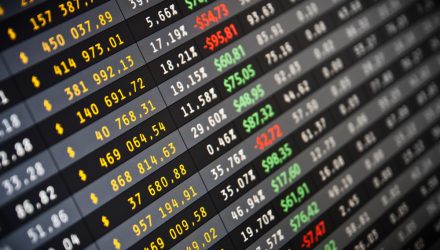With first quarter earnings results underway, one way to help mute forthcoming noise is with low volatility ETFs like the Legg Mason Low Volatility High Dividend ETF (LVHD).
LVHD helps investors straddle that fine line between risk and reward.
The ETF seeks to track the investment results of the QS Low Volatility High Dividend Index, which is composed of equity securities of U.S. companies with relatively high yield and low price and earnings volatility. The index is composed of stocks of U.S. companies across a wide range of market caps, including the largest 3,000 U.S. stocks as determined by the Solactive US Broad Market Index.
The fund will invest at least 80% of its net assets, plus borrowings for investment purposes, if any, in securities that compose the index. LVHD’s expense ratio comes in at just 0.27%.
The hunt for yield is still apparent, as detailed by a Zacks article published in Yahoo! Finance.
“The hunt for dividend in the equity market is always on irrespective of how it is behaving,” wrote Sanghamitra Saha, noting top dividend ETFs to consider. “After all, who doesn’t like a steady stream of current income along with capital gains? And if investors are mired in a web of equity market uncertainty and global growth worries, the lure for dividend investing will increase.”
Saha pointed out that a pandemic-ridden 2020 crimped the ability of companies to offer competitive dividends. However, the tide is turning in 2021.
“But things started changing as we entered the year 2021,” Saha added. “Vaccine rollout resulting in risk-on sentiments, higher inflationary expectations thanks to a super-easy monetary policy, President Biden’s $1.9-trillion COVID relief package launch and the resultant rise in interest rates are now rife.”
A Quality Dividend Screener
As opposed to simply just picking the companies with the highest yielding dividends, LVHD uses its own unique screening method. Not only must dividends be high-paying, they must also be sustainable.
The index screens for profitable companies that have the potential to pay relatively high sustainable dividend yields. Yields of the remaining securities are then scored higher or lower based on the attractiveness of their price and earnings volatility.
The portfolio is constructed of the highest scoring securities subject to concentration limits: no individual component of the Index will exceed 2.5%, no individual sector (as defined by QS) will exceed 25%, and real estate investment trust (REIT) components as a whole will not exceed 15%. The number of component securities in the Index is anticipated to range from 50 to 100.
Lastly, the underlying index’s components are reconstituted annually and rebalanced quarterly.
For more news and information, visit the Smart Beta Channel.

